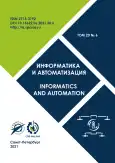Volume 20, Nº 6 (2021)
Robotics, automation and control systems
Teleoperated Service Robot with an Immersive Mixed Reality Interface
Resumo
Teleoperated service robots can perform more complex and precise tasks as they combine robot skills and human expertise. Communication between the operator and the robot is essential for remote operation and strongly affects system efficiency. Immersive interfaces are being used to enhance teleoperation experience. However, latency or time delay can impair the performance of the robot operation. Since remote visualization involves transmitting a large amount of video data, the challenge is to decrease communication instability. Then, an efficient teleoperation system must have a suitable operation interface capable of visualizing the remote environment, controlling the robot, and having a fast response time. This work presents the development of a service robot teleoperation system with an immersive mixed reality operation interface where the operator can visualize the real remote environment or a virtual 3D environment representing it. The virtual environment aims to reduce the latency on communication by reducing the amount of information sent over the network and improve user experience. The robot can perform navigation and simple tasks autonomously or change to the teleoperated mode for more complex tasks. The system was developed using ROS, UNITY 3D, and sockets to be exported with ease to different platforms. The experiments suggest that having an immersive operation interface provides improved usability for the operator. The latency appears to improve when using the virtual environment. The user experience seems to benefit from the use of mixed reality techniques; this may lead to the broader use of teleoperated service robot systems.
 1187-1223
1187-1223


Effective Functioning of a Mixed Heterogeneous Team in a Collaborative Robotic System
Resumo
 1224-1253
1224-1253


Identification of Neural Network Model of Robot to Solve the Optimal Control Problem
Resumo
 1254-1278
1254-1278


Method for Estimating Time of Wireless Transfer of Energy Resources Between Two Robots
Resumo
 1279-1306
1279-1306


Underwater Robot Manipulator Control
Resumo
 1307-1332
1307-1332


Synthesis of Line of Sight Angle Coordinate Filter on the Basis of Interactive Multi-Model Evaluation Algorithm
Resumo
On the basis of the tracking multi-loop target angle coordinate system, the article has selected and proposed a interactive multi-model adaptive filter algorithm to improve the quality of the target phase coordinate filter. In which, the 3 models selected to design the line of sight angle coordinate filter; Constant velocity (CV) model, Singer model and constant acceleration model, characterizing 3 different levels of maneuverability of the target. As a result, the evaluation quality of the target phase coordinates is improved because the evaluation process has redistribution of the probabilities of each model to suit the actual maneuvering of the target. The structure of the filters is simple, the evaluation error is small and the maneuvering detection delay is significantly reduced. The results are verified through simulation, ensuring that in all cases the target is maneuvering with different intensity and frequency, the line of sight angle coordinate filter always accurately determines the target angle coordinates.
 1333-1367
1333-1367


Spoofing Attack Detection Method for UAV Navigation System
Resumo
 1368-1394
1368-1394


An Innovative Approach to Automated Photo-Activation of Crop Acreage Using UAVs to Stimulate Crop Growth
Resumo
 1395-1417
1395-1417


Methodology for Ensuring a Comfortable Microclimate State in a Smart Home Using an Ensemble of Fuzzy Artificial Neural Networks
Resumo
 1418-1447
1418-1447











